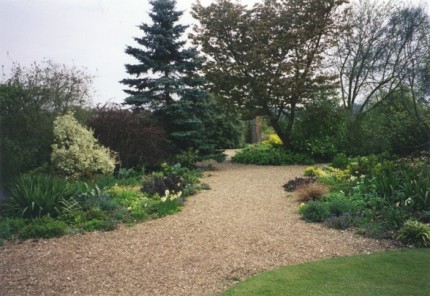The aspect that makes the biggest initial impression and, therefore, one of the main points to consider in garden design is the use of color. The palette that is selected can alter the mood of the space and even a subtle variation in tone can change the focal point to excellent effect. There are a number of ways in which spectacular results can be achieved.
Every gardener knows that care in the selection of plants is of paramount importance for a number of reasons: soil-type, the amount of sunlight available, the people who will be using the garden and the purpose for which it will be used. But as long as these factors have been taken into account, the next decision to be made is simply one of overall appearance; what type, size and color plants does the gardener want?
There is a vast difference between the multicolored, controlled mayhem of a ‘cottage garden’, featuring such plants as fragrant Lavendula angustifolia (English Lavender) and Lonicera hispidula (Honeysuckle), with their complementary, feminine pinks and purples and the ordered, meditative arrangement of a formal Japanese garden with its tendency to focus on a broad variation of color or shade of leaves and using only a few pale blooms, such as Prunus pseudocerasus (Japanese Cherry), as relief. However, even in these two very different types of garden, the colors can be enhanced by the use of a variety of decorative aggregates: slate, gravels, cobbles and pebbles of varying size and color.
In a garden containing a large variety of different colored flowers, a common theme can be created by laying beds or connecting paths of less exuberantly hued materials, such as the understated greys of Caledonian Pebbles or Dapple Flint or one of the subtler shades of slate, such as ‘rustic’ or green. This would draw the eye where the gardener wants it to go, creating patterns and lines to augment the natural beauty on display. Conversely, through a measured use of bolder colours of aggregates, for example, Purple Slate, Cheshire Pink gravel, Golden Flint or Red Rustic Chippings, selected areas in the garden can be decorated in a specific colour-scheme, matching plants to aggregates to reinforce the effect of the colour, forming mood-enhancing areas, just as an interior designer would create moods inside the house through choice of paint, paper and fabrics.
To create a sense of tranquility throughout the garden, for example, where a Japanese theme has been selected, the subtle differences between the myriad shades of the different types of leaves can be greatly enhanced by a uniform backdrop. Phyllostachys vivax bamboo, known as ‘Aureocaulis’ because of its beautiful golden undertones, can be overshadowed by more flamboyant foliage such as that of the many variants of Heuchera available, which are frequently used to good effect in this setting, but Aureocaulis and Heuchera can co-exist in splendour when set against a ‘carpet’ of either white, provided by pebbles or gravel or a cool grey provided by slate; the single background colour framing the gold of the bamboo and the spectacular colours of Heuchera whilst preserving their individuality.
These are just some of the many ways in which a gardener of any level of capability can use a combination of plants and aggregates to create and maintain a beautifully coloured garden. Mark Finch works at the aggregate shop providing customer support and advice on a range of aggravates.




